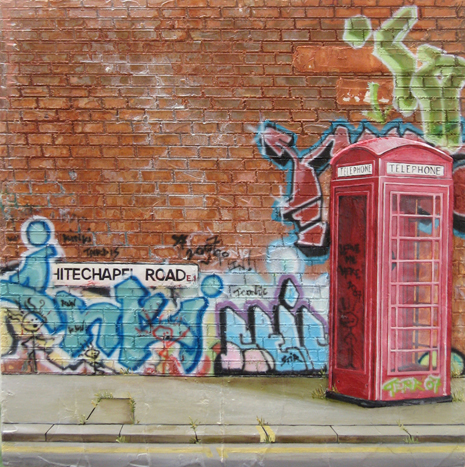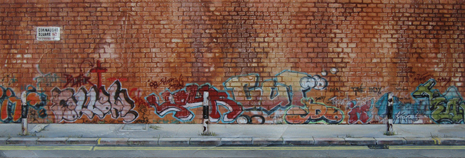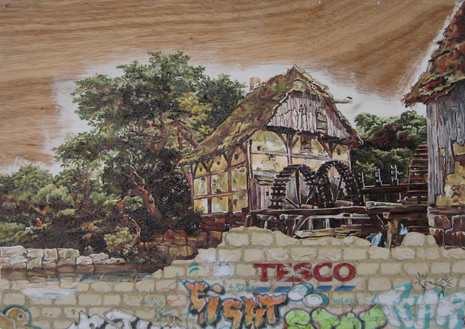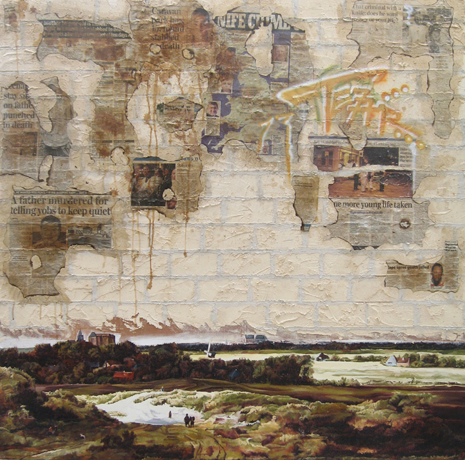As we continue to build on the previous two interviews, UK Street Art had the opportunity to interview another of the rising stars in the urban art scene. This time it was Miranda Donovan, who will run you through her influences, why she chose 3D as a medium for her work and what’s next for her.
Check out the interview after the jump
If we start from the beginning, what would be your earliest influences on how you got in to the artform and where you are today?
As a child I loved colouring books and cartoon characters. Garbage Pail Kid stickers were a particular obsession of mine because of the hundreds of different characters, names and colours. If I was given pocket money it would go on buying another pack of these stickers or comics. When I was 6 I remember being given 5 pounds and making the enormous decision to spend the whole lot on a box! I loved buying The Beano and Dandy and later on I enjoyed looking at the different characters in Viz. I often didn’t care what the stories were about but simply enjoyed looking at the characters because of their form and colour.
I had a classical background with a History of Art degree. I was particularly drawn to the works of the German Expressionists, specifically the Die Brucke group, because their work is vivid in colour, communicates emotional tension and draws on Primitivism. Graffiti too is vivid in colour, enables someone to leave their mark in society so holds an emotional value whilst it could also be regarded as quite a primitive and childlike thing to do if seen as vandalism. I then lived near Marseille where graffiti had its first major impact on me.
How did you become interested in graffiti and what’s your reason for taking it off the street and into the gallery?
Graffiti first started to enter my conscious whilst living down in the South of France outside Marseille. You can’t fail to notice it. It’s everywhere. I got to know a graffitist down there who amusingly worked for the mayor by day and tagged at night, but it wasn’t until I returned to London that my obsession with graffiti begun. Whenever I passed the Lucozade building that used to be on the A4 flyover (it was pulled down about 4 years ago now) I had this desire to paint it. So I did and realized it was the graffiti pulling me in. My reason for taking graffiti off the street and into the gallery began as something very subconscious.
You’re half Dutch – does this come into your work in any form?
Yes. Recently work by the Dutch 17th Century Landscape painters: Jacob Van Ruisdael and Jan Van Goyen have been of great inspiration. The immense skies and low-lying land so pertinent to Holland and so apparent in the work of the aforementioned artists is something I have a great affiliation with whilst at the same time this division of space has become an integral part of my work in that the brick “walls’ are the immense skies and the low lying land is the pavement or scrubland.
And who do you see as modern influences?
When it comes to the sculptural element in my work artists such as Antoni Tapies and Anselm Keifer are of particular influence to me. I would say 80% of graffiti I see on city streets and in rural settings inspires and influences me.
Why did you decide to work in 3D – what’s different from this instead of working 2D, and do you think it does really add more “dimension” so to speak to your work?
I decided to work in 3D because of a desire to create something that looked very real without being photographic.
In addition when I see graffiti it isn’t only graffiti that arouses me but also the texture and tactility of the surface on which it is found. In my opinion the surface and immediate surroundings wherein graffiti is found contribute an enormous sense of character. A wall has a story of its own communicated through the “type” of wall it is ie what the bricks look like: clean cut bricks; crumbling bricks, smooth bricks etc what the overall appearance of the wall is; does it have cracks, crevices, fading weathered colours and so on that have appeared over time. By building up a 3D “brick wall” scene my intention is to communicate to the viewer the beauty of mark making on a textured surface that, in my opinion, is so much a part of the graffiti and in so doing makes the viewer conscious of the beauty and power of graffiti as opposed to something that can be disregarded as pure vandalism.
Building a sculptural 3D surface creates something very tactile, which in itself often draws the viewer in and evokes within the viewer a desire to touch. When I look at something 2D, ie a painting it is rare that I have a desire to touch it whilst a 3D object instinctively makes me want to reach forward touch it and run my hands over it. As such an aim of mine is to draw the viewer in by evoking two senses: sight and touch so adding an extra dimension to the work.
I know that you started your work by the exploration of “types” of housing, and you’ve now moved on to the study of specifics within architecture – what caused the decision to make this shift?
At the time this was a subconscious decision. In retrospect however I wanted to re-challenge myself. Having explored a multitude of housing and building “types” from Canary Wharf, to Council blocks and Shanty Towns it seemed a natural progression to focus on the specifics in architecture. Whilst I wanted to move my work forward in new directions I also wanted to retain the structural elements of architecture. The linear, grid like characteristics of architecture, also seen in brick walls, give a sense of order in contrast to the anarchical characteristics of grafiiti, which pose a threat to this order.
How does your work blur the boundaries between object, sculpture and painting?
The first process of my work is creating or “building” a textured surface into which I carve the bricks and sculpt various architectural elements and onto which I will then paint. Whilst I “build” this highly textured surface onto the flat 2d surface of the support I also “build” it around the sides of the support giving the piece a sculptural appearance. On completion the works are framed in Perspex boxes. This adds a further dimension. The pieces become jewel like objects, something to be looked at but not touched, protected. Framed in this way the smaller pieces can be free standing, like a sculpture but can also be hung flat against a wall like a painting. The boundaries are blurred because the pieces are neither one set thing nor the other but have characteristics of an object, sculpture and painting without being one set thing.
Do you think your sculpture work is a statement about the environment we live in? And do you make everything from scratch; the smallest detail upwards?
Yes “building” walls definitely makes a statement about our environment. Not only have we witnessed a recent building boom but the erection of new buildings, houses, city walls etc is something that has taken place continuously throughout history.
And yes each work is “built” from scratch from the smallest detail upwards.
Do you make commentary on London through your work?
Whilst some works are a commentary on London I would argue that as a whole my work presents a world of paradoxes specific to society in general. The more serious works that focus on gang stabbings and shootings raise questions about a social problem ever present in London but other cities such as Glasgow too. The big brother “eye” watches us not just in London but even in a scrubland. The capitalist Tesco takeover is not just becoming an eyesore on many London streets but is also ruining rural settings at a rapid pace. The pieces more specific to London are arguably the more ironical and lighthearted: tagging prestigious London landmarks impervious to vandalism in real life, presenting Al Fayed’s big department store as a big shop of “horrors”, using one of the most famous streets in London; “Shaftesbury Avenue” as a tool to communicate a view that “all the world’s a stage and all the men and women merely players”.
As the graffiti/street art scene keeps evolving, do you see it taking a step in the direction of where you are at now; creating not only 2d markings on surfaces, but also creating the surfaces they go on – do you think a whole space will become an “installation” rather than a gallery with paintings/prints hanging on the walls?
In many respects I think this is already happening. Take the Cans Festival. Graffiti artists weren’t just putting their pieces on walls but installed smashed up, burnout cars that were covered in graffiti and furniture too. The tunnel where the festival took place became an outdoor gallery where people had to queue to see the work.
I think your work is comedic, is this a conscious thing? Why is this your intention?
Yes there is a consciously comical element to some of my work. I think there is a massive amusement factor to graffiti. Take Banksy. His work is full of wit and humour and certainly puts a smile on many a face. He outwits the authorities. And people, I believe, feel an affiliation with rebellion. If we’re always being told what to do and continuously being watched it is human nature to retaliate. If you’re told you’re not allowed to do something is it not fun to go and do that exact thing? Imagine the faces and reactions of those that live in affluent parts of town or politicians arriving at the Houses of Parliament to find their worlds have become a canvas for graffiti.
How do you feel about being a woman in the scene – do you think it’s male dominated, and if so, is that an issue?
In all honesty this is something I have never given much thought to. I know it is a male dominated scene but I don’t have an issue with that. On the contrary I almost relish being in the minority.
Where do you see the street art/graffiti scene going – do you think it’s becoming too mainstream, or do you believe that the work that all the galleries are doing are helping to further the development of it? Or do you think there are quite a few people jumping on the bandwagon?
There’s no doubt the street art/graffiti scene is becoming more mainstream. It is used in everything from advertising to shoe designs. In this respect I do feel big corporate companies are jumping on the artist bandwagon. However bringing street art/graffiti work, created by the artists themselves, into the gallery is the only way forward. Graffiti/Street Art is the landscape of the 21st Century. In addition everyone can understand it because it is a part of their existence today. There is no elitism attached to it. You don’t have to have done an Art Degree to understand it. Yes it is probably true to say that “real” street art will always be produced in illegal places on the street itself. However I think the fact that it is being recognized as an art form rather than as vandalism is a good thing. The recent graffiti project that took place at Tate Modern is a massive positive step forward because graffiti is the most relevant art form today. People like Blek Le Rat and Banksy have views that deserve to be listened to. Plus graffiti art should be regarded as the murals or frescoes of the 21st century. Murals date back to prehistoric times and frescoes were outdoor egg tempera paintings that were a huge part of the early Italian Renaissance. In my opinion graffiti is comparable. I wouldn’t be surprised if in time more and more people commission graffitists to do pieces on their houses just as patrons commissioned artists during the Italian Renaissance to paint frescoes.
How do you see yourself differing from the other artists in the same field – do you even place yourself alongside the likes of Banksy, Faile, Micallef etc?
The most immediate difference to the artists mentioned above is that I do the majority of my work in the studio rather than on the street. In this respect I don’t place myself alongside them.
What’s next for you – where do you see yourself going in the future?
The second Album!
- Tags: Interview, Laz Inc, Lazarides Gallery, Miranda Donovan




2 Comments
This is a new low, this looks like a bad version of what graphic designers where pumping out in the 80s when clients wanted ‘cool hip street’ (which was a bad version of bad graffiti) think all those wanna be Electro lp covers. Please say this is a joke and youre just trying to wind us up, or is done by mentals, like when that gallery in New York passed of pictures painted by monkeys as ‘real art’.